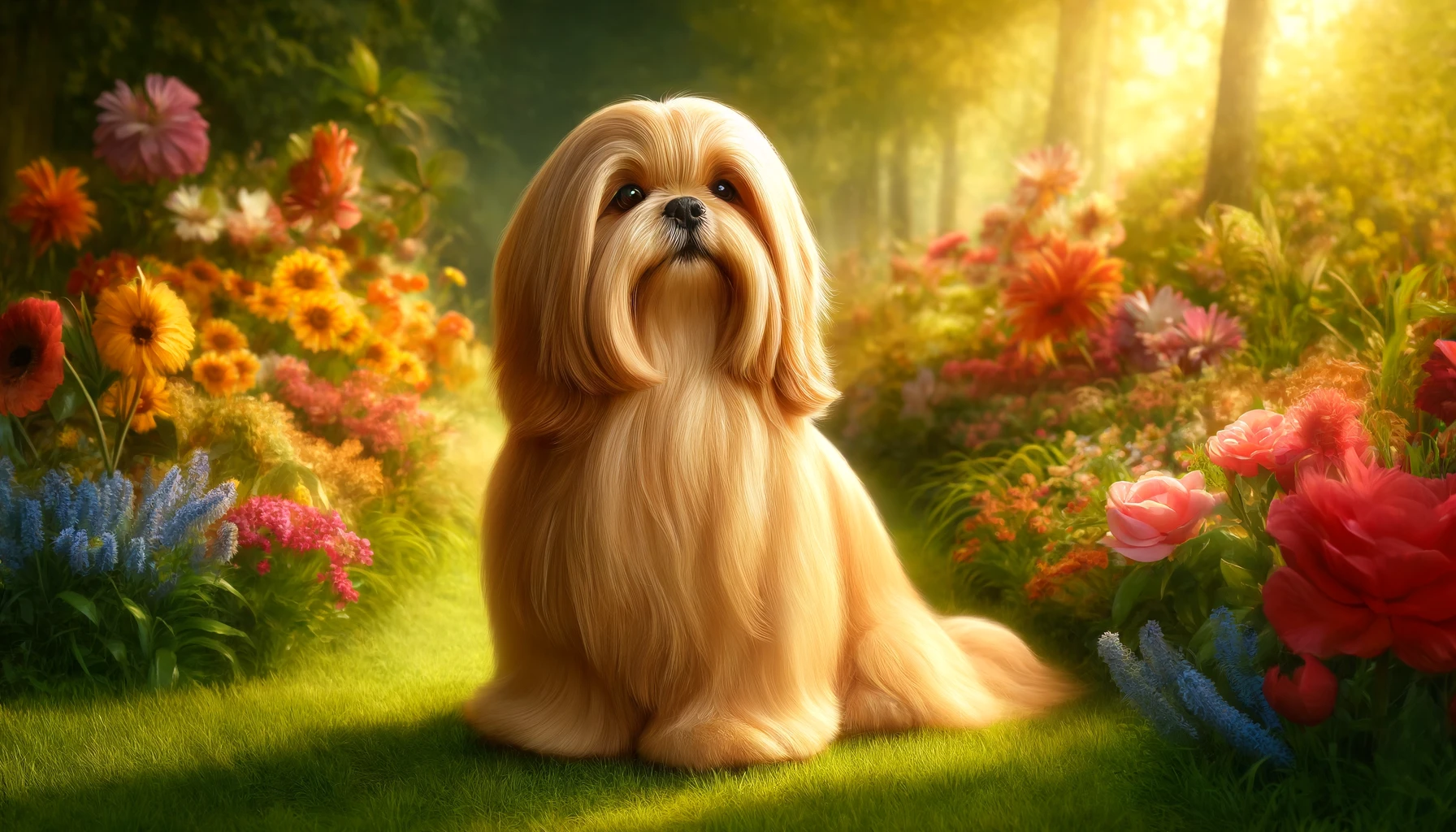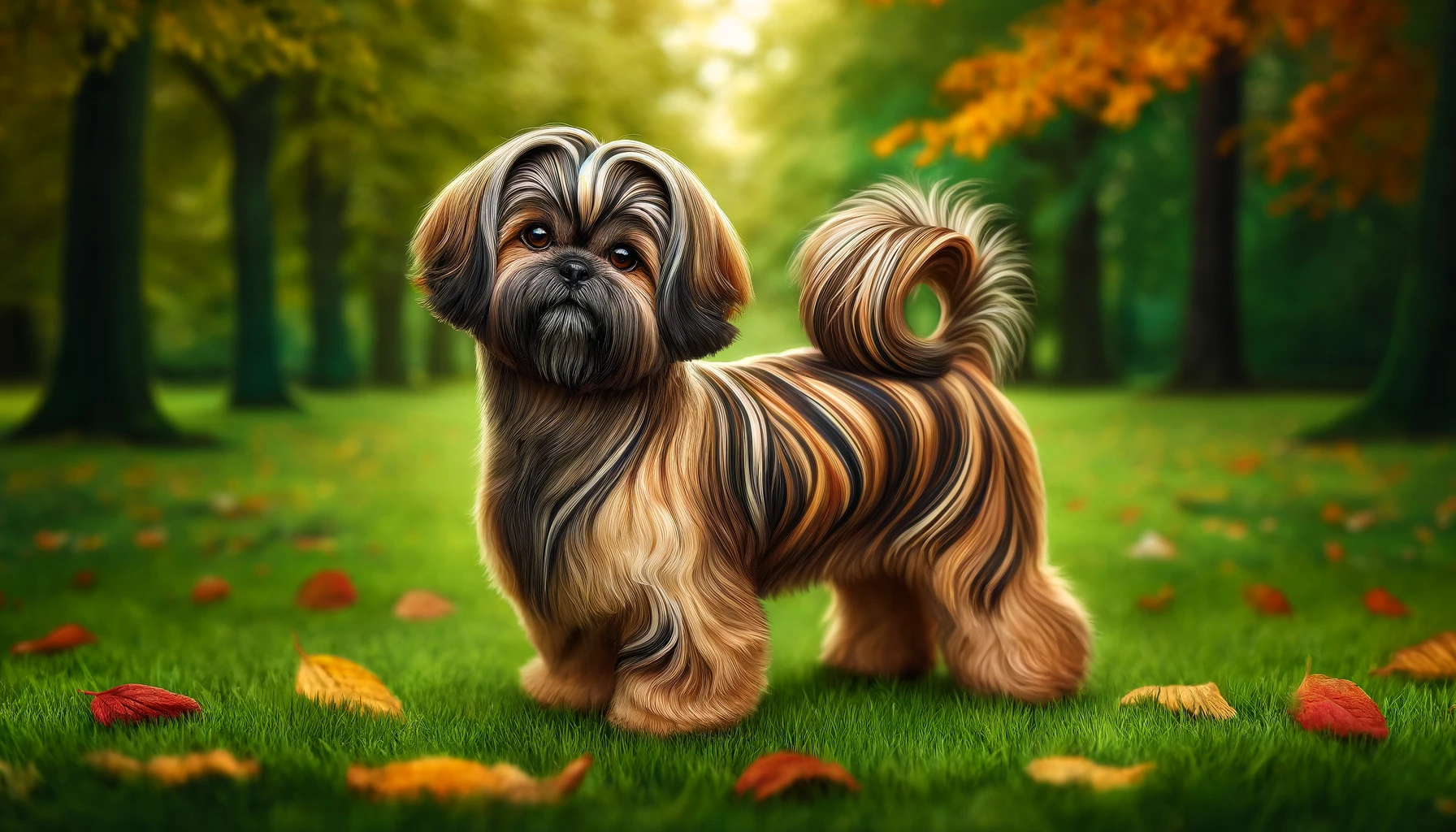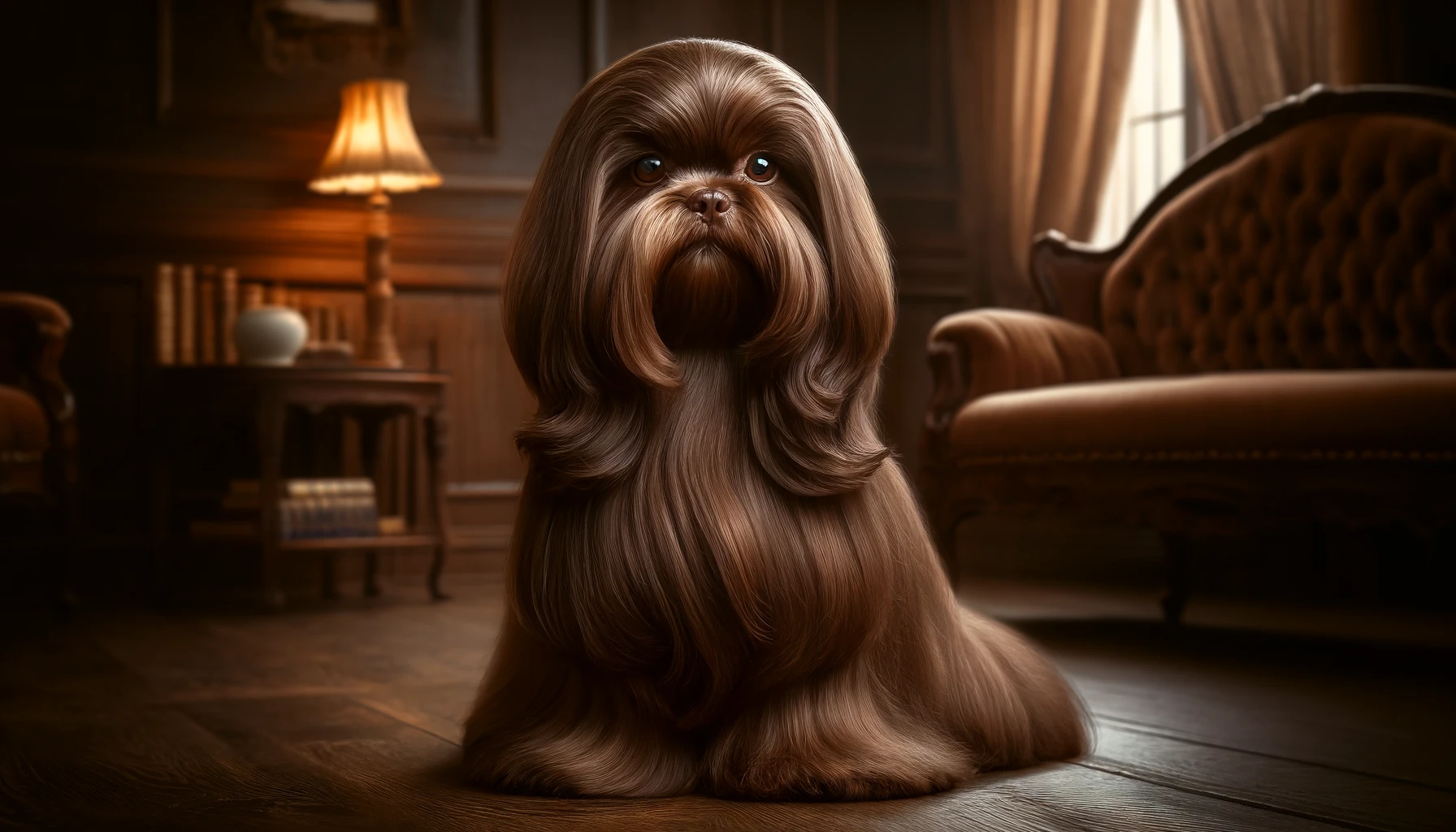The Shih Tzu, a toy breed known for its friendly demeanor and luxurious coat, boasts a fascinating array of colors that adds to its allure as a companion pet. Originally bred in China as lap dogs for royalty, Shih Tzus are small in size but big on personality, often described as having a chrysanthemum-like face where the hair grows in every direction. One of the most appealing aspects of the Shih Tzu is its coat, which can display a variety of beautiful and unique colors and patterns. This variety not only makes each Shih Tzu distinct but also allows for a wide range of personal expression for owners who enjoy grooming their pets to show off these colors. In this article, we explore seven stunning color variations of the Shih Tzu, showcasing how each color variation contributes to the charismatic presence of this beloved breed.
1. Black

Solid black Shih Tzus are a sight to behold with their deep, glossy coats that can shimmer like silk under the sunlight. This color is relatively rare in the breed, making a solid black Shih Tzu a coveted variety among enthusiasts. The intense black hue highlights the expressive eyes and adds an air of mystery and elegance to their appearance. Despite their dark coat, black Shih Tzus carry the same playful and affectionate nature that the breed is known for. They can serve as striking contrasts in multi-colored litters and are particularly impressive in the show ring where their gleaming fur can truly stand out.
2. White

Pure white Shih Tzus are prized for their pristine and graceful appearance. Their snow-like fur can make them look like small, animated plush toys, especially when their coats are fully groomed and flowing. White Shih Tzus can have a regal bearing, embodying purity and calmness that often captivates onlookers. This color, while requiring significant maintenance to keep clean, offers a canvas for showcasing the vibrant personalities of these dogs. Their loving and outgoing nature wrapped in a white coat makes them not just pets but also companion pieces of living art.
3. Gold

Gold Shih Tzus radiate warmth and beauty, with their shiny golden coats that can range from light buttery hues to deep amber. This color enhances their friendly face, making them look even more inviting and cuddly. The gold-colored Shih Tzu is popular for its cheerful and sunny appearance, often reflecting their happy and upbeat disposition. Owners of gold Shih Tzus find them not only eye-catching but also great at expressing their affection, making them perfect family pets who are always ready to play or snuggle.
4. Brindle

Brindle Shih Tzus are particularly unique, featuring streaks of color in a tiger-striped pattern over a base coat. This coloration is dynamic and can change subtly as the dog matures and its coat grows longer. Brindle Shih Tzus are often the center of attention due to their distinctive patterning, which makes each one of them one-of-a-kind. Their playful and sometimes mischievous personalities seem to match their wild, colorful exteriors, making them beloved by those who enjoy vibrant and standout pets.
5. Liver

Liver-colored Shih Tzus have a warm, chocolatey brown hue that covers their entire body, including their nose, lips, and paw pads. This color is due to a recessive gene that affects the pigmentation. Liver Shih Tzus are rare and thus highly prized. Their deep, rich color gives them a luxurious look that is enhanced by their affectionate and gentle temperament. Owners of liver Shih Tzus often remark on the softness of their coats and the depth of their color, which can be quite mesmerizing in sunlight.
6. Blue

The blue Shih Tzu does not refer to a true blue color but rather a diluted black that appears as a deep blue-grey. This striking coloration is often associated with a silky texture and a glamorous sheen that is highly desirable. Blue Shih Tzus can sometimes have a mysterious or noble look, making them stand out in a crowd. Coupled with their loving and calm demeanor, blue Shih Tzus make excellent companions for those looking for a dog with a unique appearance and a tranquil personality.
7. Parti

Parti-colored Shih Tzus feature two or more distinct colors, with white often being a prominent part of the mix. These Shih Tzus are celebrated for their patchwork appearance that gives each dog a unique set of markings. This variation allows for a playful array of patterns that can include any of the previously mentioned colors combined in intriguing ways. Parti Shih Tzus are especially popular among families, as their fun appearance matches their lively and affectionate nature.
Shih Tzus are not only cherished for their adorable looks and loving temperament but also for their diverse color palette, which adds to their appeal. Each color variation brings something special to the breed, enhancing the Shih Tzu’s reputation as a delightful companion dog. Whether adorned in a solid, luxurious shade or a playful parti pattern, each Shih Tzu carries a beauty all its own, making this breed a perfect choice for dog lovers who appreciate both aesthetic appeal and engaging personality.
Frequently Asked Questions About Shih Tzu Colors
1. What are the most common colors for Shih Tzus?
Shih Tzus are known for their beautiful and diverse coat colors. The most common colors include black, white, gold, and various shades of brown. Many Shih Tzus display a combination of these colors, often seen in patterns such as black and white, or brown and white. These colors can appear in either solid blocks or a more mottled pattern, depending on the specific genetic inheritance of the dog. The richness and variety in the Shih Tzu’s coat make each dog distinct, with some having symmetrical facial markings that add to their appeal. Coat color can change as the dog ages, with many puppies darkening or lightening as they grow into adulthood.
2. Are there any rare colors for Shih Tzus?
Yes, some Shih Tzu colors are considered rarer than others. The rarest include solid black, solid liver, and blue. These colors are rare due to the specific genetic combinations required to produce them. A solid black Shih Tzu, for example, must inherit the black pigment gene from both parents, while liver and blue Shih Tzus result from recessive genes that affect the pigmentation in the coat and skin. These rare colors are often sought after for their unique appearance but are no more valuable in terms of personality or health than more common colors.
3. Can Shih Tzu coat colors affect their health?
In most cases, a Shih Tzu’s coat color does not directly impact their overall health. However, dogs with lighter or white coats can be more susceptible to skin cancer if they are frequently exposed to the sun without protection. Additionally, certain colors like blue and liver can be linked to a genetic condition known as Color Dilution Alopecia, which can cause hair thinning and skin issues. It’s important for owners of Shih Tzus with these colors to monitor their skin and coat health closely and consult a vet if they notice any abnormalities.
4. Do Shih Tzu puppies change color as they grow?
Yes, Shih Tzu puppies can change color as they mature. It is not uncommon for their coats to lighten, darken, or change in pattern. For example, a puppy that appears black at birth might lighten to a dark gray or silver as it ages. This change can be influenced by genetics, and the final adult color can sometimes be different from what might have been predicted when the puppy was younger. Breeders often can predict these changes based on the colors of the puppy’s parents and previous litters.
5. What determines a Shih Tzu’s coat color?
The coat color of a Shih Tzu is determined by genetics. The interaction between multiple genes dictates the distribution and type of pigmentation in the dog’s coat. These genes control whether a Shih Tzu will be solid-colored, have markings, or display a more blended pattern. Additionally, some genes control fading and intensifying of colors, which might change as the dog ages. Understanding these genetic influences can be complex, and breeders often use genetic testing to predict the color outcomes of their litters.
6. How do I maintain the vibrant color of my Shih Tzu’s coat?
Maintaining the vibrant color of a Shih Tzu’s coat involves proper grooming and nutrition. Regular bathing with a high-quality dog shampoo can help prevent dirt build-up that dulls the coat. Additionally, using shampoos formulated to enhance the natural color of your dog’s coat can help maintain its vibrancy. A balanced diet rich in essential fatty acids, particularly omega-3 and omega-6, will support a healthy, shiny coat. Supplements like fish oil can also be beneficial. Protecting your Shih Tzu from excessive sun exposure is crucial to prevent fading and maintain coat health.
7. What is the most popular color combination for Shih Tzus?
One of the most popular color combinations in Shih Tzus is the classic black and white. This striking contrast gives these dogs a tuxedo-like appearance that is highly appealing to many owners. Another popular combination is white and gold, which features a lovely blend of creamy white and warm golden patches. These color combinations stand out in the show ring and are also favored for their aesthetic appeal in a family pet setting.
8. Are certain Shih Tzu colors more expensive?
Certain Shih Tzu colors, especially the rarer ones such as solid black, liver, and blue, can be more expensive due to their scarcity. Breeders might charge more for these colors because they occur less frequently and are in higher demand among potential owners who seek a unique-looking pet. However, the price should not be the sole factor in choosing a pet; health, temperament, and the breeder’s reputation are far more important considerations.
9. Can Shih Tzus have multicolored coats?
Yes, Shih Tzus can have multicolored coats, which are actually quite common in the breed. These can range from simple two-color combinations to more complex patterns featuring three or more colors. Common multicolored patterns include brindle, parti, and tri-colored. These variations add to the breed’s charm and make each individual dog unique in appearance.
10. How does sunlight affect a Shih Tzu’s coat color?
Sunlight can affect a Shih Tzu’s coat color by causing it to fade, especially in dogs with darker or more vibrant colors. Prolonged exposure to the sun can bleach the coat, making it appear lighter or washed out. To protect your Shih Tzu’s coat color, it’s advisable to limit direct sunlight exposure during peak hours and consider using canine sunscreen on light-colored or thin-coated areas when spending extended periods outdoors. Regular grooming and coat care can also help mitigate the effects of sun exposure.
The post Shih Tzu Colors: 7 Stunning Variations with Pictures appeared first on iHeartDogs.com.
via
Whisker Therapy







